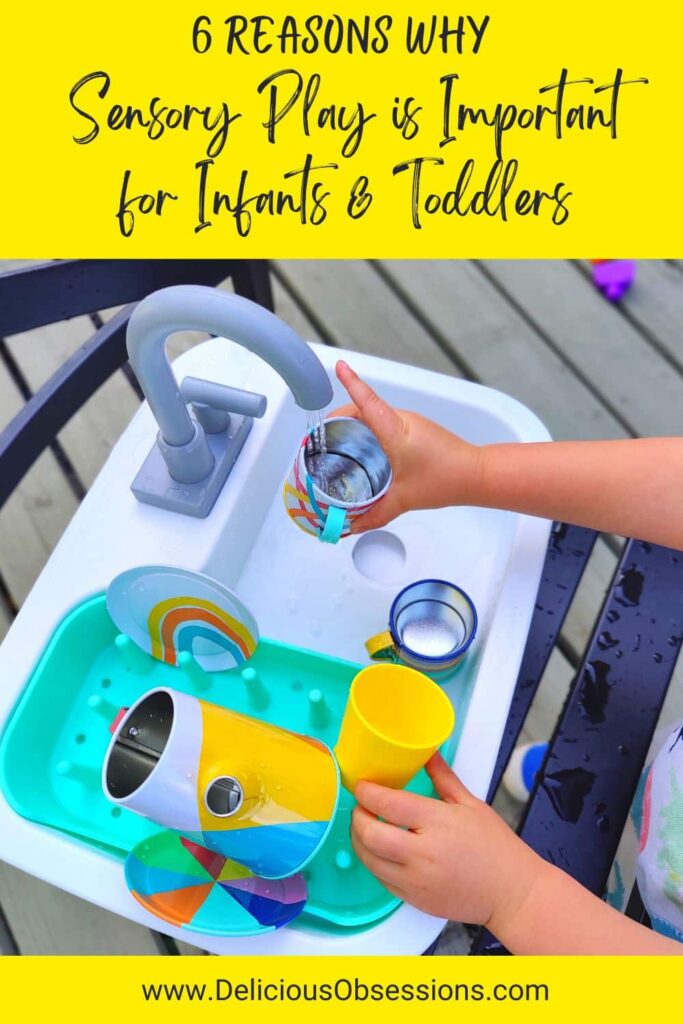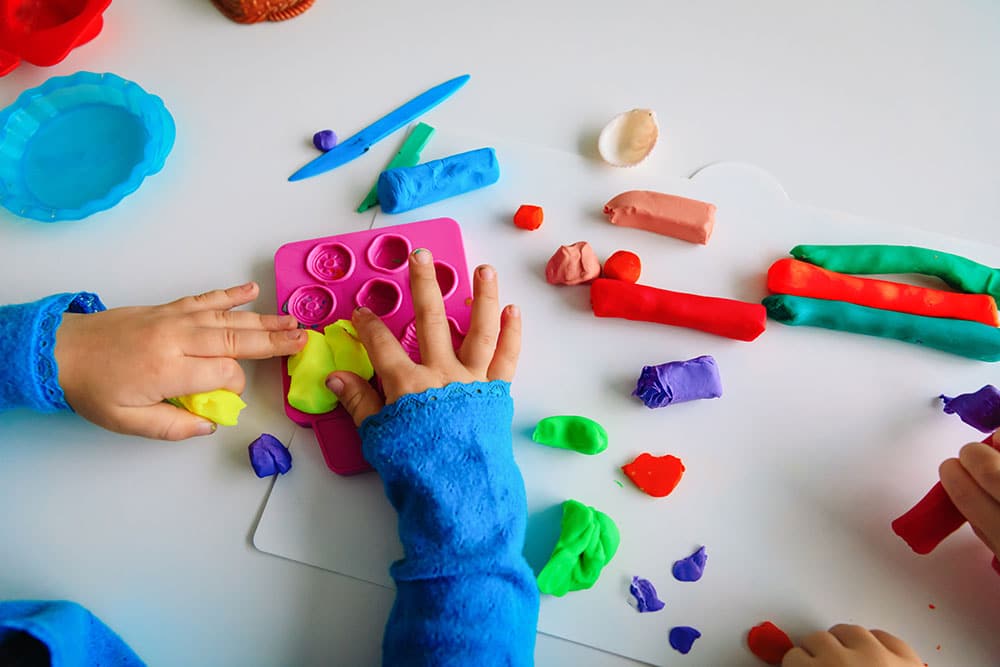FTC Disclosure: Delicious Obsessions may receive comissions from purchases made through links in this article. As an Amazon Associate I earn from qualifying purchases.Read our full terms and conditions here.
Have you heard of sensory play? It’s a form of play that allows young children to immerse all of their senses in an activity. This form of play has been shown to help them develop better fine motor and language skills, as well as learn things like basic math, science, and problem-solving. This is definitely a form of play that all families should incorporate regularly.
It’s just my personality to want to understand the “why” of things, especially when it comes to my kid. What I have learned is that sometimes you can’t understand the “why” because toddlers are a special breed of their own. Their brains are going through such intense and rapid development that often they act irrationally and you just have to roll with it.
But that’s not what I’m here to talk about. Because brain development in toddlers would take an article all on its own. In an effort to understand the “why” behind my little one’s temper tantrums, I learned that during this time they are making 1 million neural connections EVERY SECOND! So that helped me take a little step back and breath when he goes into meltdown mode.
Anywho, on to today’s post.
Sensory Experiences for Babies and Toddlers
One thing I started early on with Jacob was sensory experiences. Using lots of different textures and sensations for learning. When he was really little, I used different pieces of fabric and other materials to give him a tactile experience. As he got older, I started making sensory bins for him. I had seen sensory bins and sensory play mentioned many times in the groups I am in, but I wanted to know more about the “why” of these activities and brain development. And that’s what I want to talk about today.
Sensory experiences are a really important part of brain and skill development in babies and toddlers. It’s one that most children are probably already doing (i.e. playing with their food or jumping around in mud puddles), but I think it’s also good to know WHY this form of play is good. When I know the why of things, I tend to do better at incorporating those things into my life. Or in this case, my toddler’s life.
This post is geared towards information about why sensory experiences are good for young children. I have a follow-up post coming about how to easily and cheaply make your own sensory bins at home, which is what we most often use.
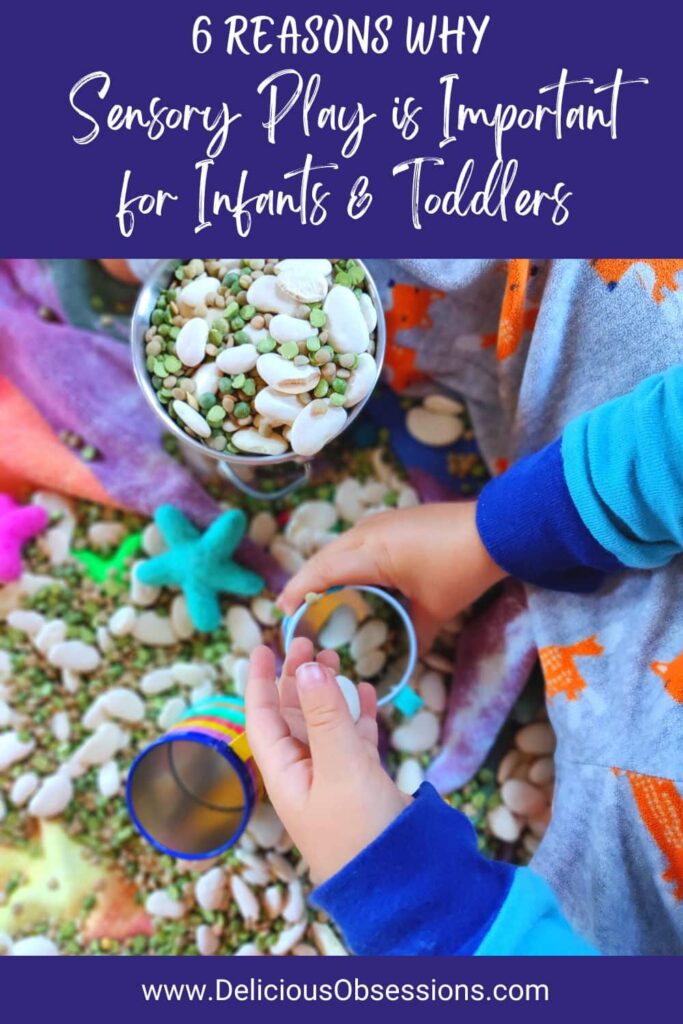
6 Reasons Why Sensory Play is Good for Baby and Toddler Development
In the simplest terms, sensory play allows children to explore their world in a tactile way that engages all of their senses. Not only do they learn about the world through sight, touch, sound, smell, and taste (yes, they will likely taste some of these things), but sensory play can also help them develop and improve:
- Fine motor skills
- Language through verbally identifying items
- Basic mathematics by counting, weighing, etc.
- Basic life skills like pouring, sorting, cleaning, etc.
- Basic science like gravity, density, volume, etc.
- Problem-solving
This is not even a comprehensive list either! Sensory play can be some of the very best play for your child(ren) and it can be a great way to get them outside too. My best advice is to do most of your sensory play outdoors, as it can often get messy. And keep in mind there are actually many benefits to messy play too. According to my favorite baby and toddler development partner, Lovevery:
When a child puts their hand in paint, a set of nerve cells in the brain captures information about how the paint looks as it smears. A separate set of neurons codes how the paint feels squishing between their fingers. The sound of the squishing paint and paper crinkling as a toddler’s hand moves around is “recorded” by yet another set of neurons.
Up until about 8 months, babies experience sensory input one sense at a time. As your baby gets older, their brain will start to link input from the five senses—touch, sound, sight, smell, and taste. In order for any of those individual senses to give them meaningful information about the world, they need to be linked in the brain—and this is the case for getting messy. (Source)
For further reading on this topic, check out these posts from Lovevery:
- Sensory play (and why letting your baby get messy is important)
- 4 fun sensory activities that build neural pathways
- The case for messy sensory play: ideas for right now
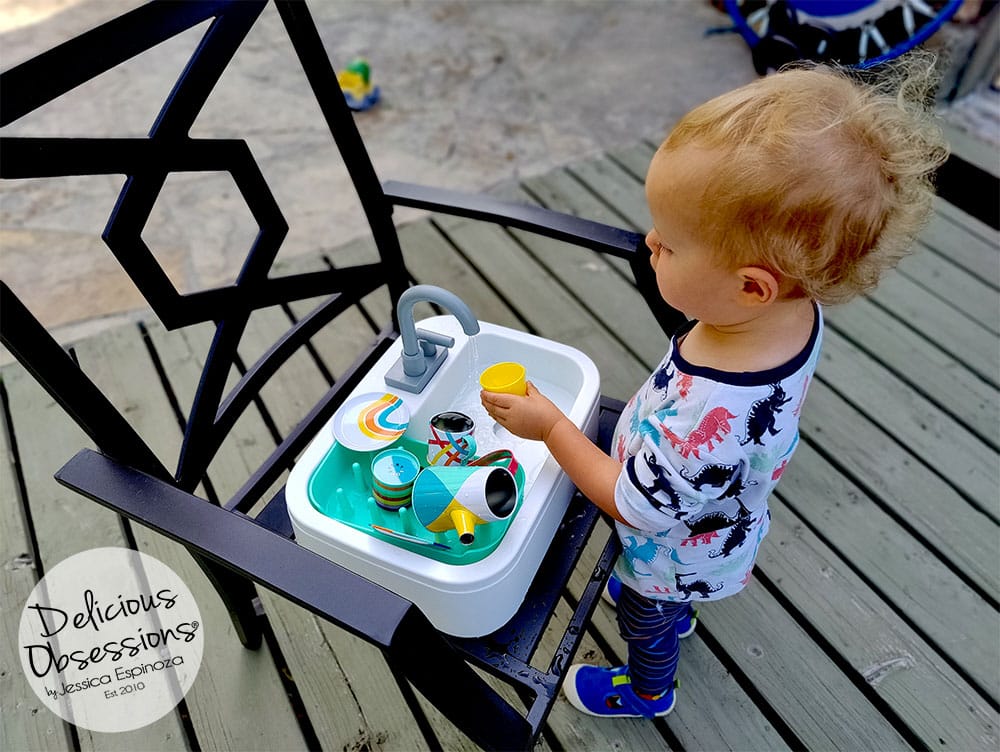
What Does Sensory Play Look Like
Sensory play can really look like a huge variety of things. A quick Google search is going to yield a bazillion ideas for sensory play. Really, it’s anything that allows children to utilize all of their senses. It could be anything from playing in a mud puddle or roaming through the forest, to counting dry pasta or playing with homemade slime. Some popular examples are:
- Bins filled with dry pasta, rice, beans, etc. with cups, bowls, scoops, small toys, etc.
- Shaving cream or whipped cream, colored with food coloring.
- Water beads, either by themselves or in another tub of water.
- A water table or tub of water with a variety of pitchers and cups for pouring.
- Playdough with different things to use as molds, cutting, shaping, imprinting, etc.
- Kinetic sand or moon sand (can be purchased premade or DIY).
- Cooked pasta that has been cooled. Can add things like tongs, bowls, etc.
- Chia seed goo or homemade slime.
- Ice cubes with little toys or pom poms frozen inside them.
The list could literally go on and on and on. There are so many things that you could do to encourage sensory play, far more than I could ever list. Get creative!
I will say that what your child likes is going to depend on their personality. For example, Jacob is not a fan of getting super messy right now. He doesn’t like things like shaving cream or homemade goo. I’ve noticed that he doesn’t like having messy, sticky, or slimy things on his hands (his dad and grandmother are like this too, so I honestly think it’s genetic). So we tend to stick with either a water table or dry sensory bins, although I do continue to offer opportunities for messy play. I’ll never force him to get messy but since I do believe in the benefits of messy play, I will encourage it whenever possible.
In my next post, I will share some of my favorite sensory bins that Jacob uses for sensory play, so stay tuned for that!
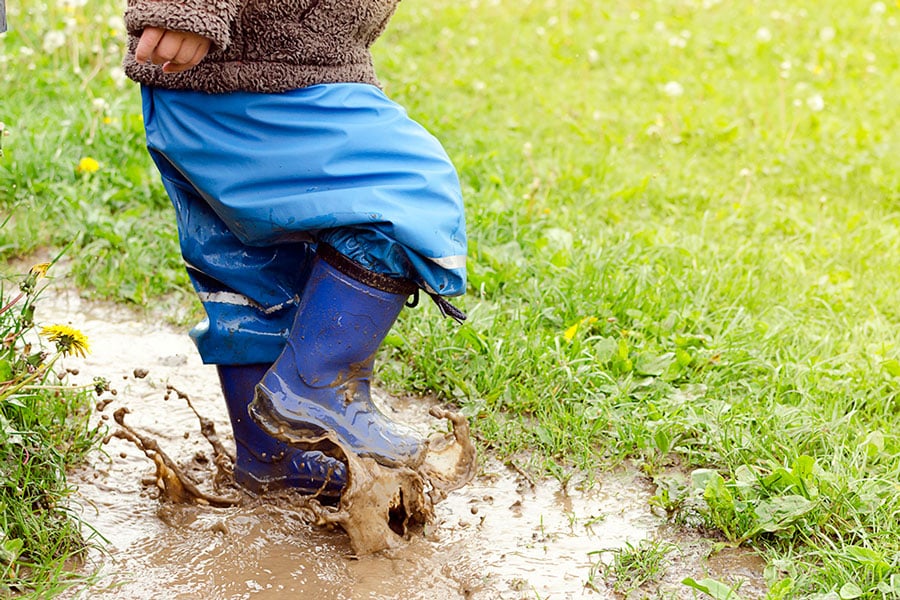
Sensory Play Made Easy with Lovery
I know that for some parents, sensory play can feel overwhelming and too messy. I get it. Hence the reason we do most of our sensory experiences outside. There are so many things that you can do for sensory play that are cheap and even free. But for those who are looking for other age-appropriate ideas and toys for your little ones, let me take a moment to tell you about Lovevery.
Lovevery is an amazing company that I have been blessed to partner with for almost a year now. Their goal is to help every parent feel confident educating and encouraging their child’s development. Their play products are designed by child development experts and distilled to their simplest, purest purpose: to be exactly what children need at each stage.
They create specially designed kits for young kids up to 4 years old. From newborn to 4, you can find everything you need to entertain and educate your children without a lot of stress and overwhelm. If you want to learn more about my own baby and toddler development journey, I’ve written several posts about this topic that have featured Lovevery’s products here:
- 5 Reasons Why Hand Strength and Dexterity Are Crucial for Baby and Toddler Development (+ 5 Toys That Help!)
- 5 Ways to Incorporate Montessori Learning Methods at Home (even if you know nothing about Montessori!)
- 5 Reasons Why Building Blocks Are Good for Toddler Development
The Lovevery Kits are designed by scientists and pediatric/childhood development specialists to ensure that children stay entertained and challenged at the correct level for their age. The kits feature a wide variety of toys and activity ideas delivered right to your door. In addition, many of the toys are made of sustainable materials like wood and organic fabrics. Very Montessori-inspired, so for those who like aesthetically pleasing items and want to keep clutter to a minimum, these kits might be a great option for you.
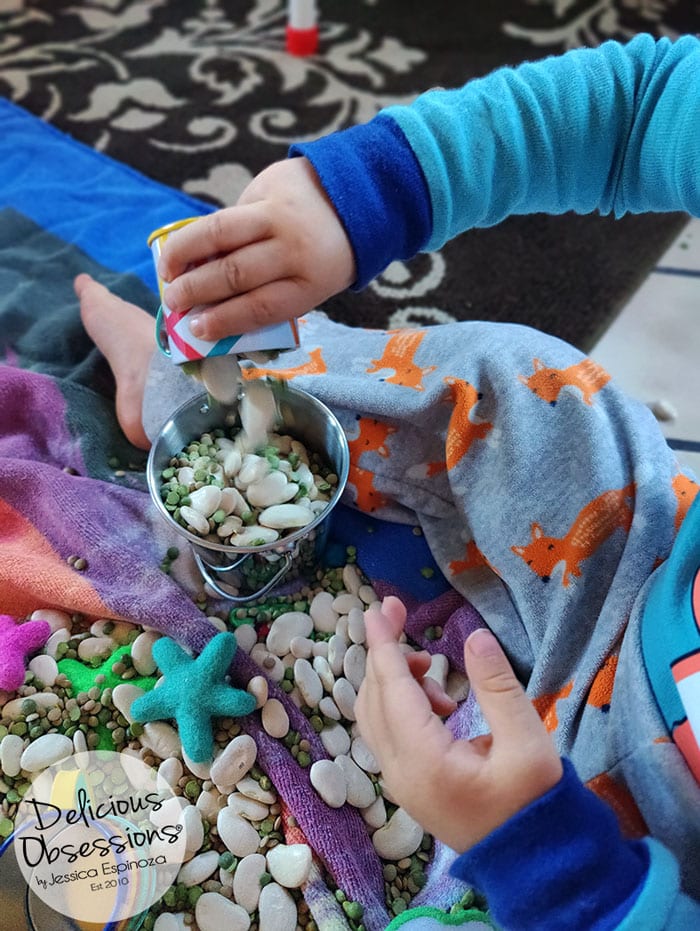
How We’ve Used Lovevery Kits for Sensory Play
I’ll share more about this in the upcoming DIY post, so stay tuned for that. So far, we have enjoyed the following kits as Jacob has grown (I honestly wish I had used their kits from the beginning — it would have simplified life!). The really awesome thing about these toys is that they don’t just automatically outgrow them when that time frame is up. Jacob still plays with almost everything we’ve received from Lovevery.
The Pioneer Play Kit (Months 16, 17, 18) – Jacob still plays with all of the toys from this kit and loves the round stacker and the Max and Nana Go to the Park book. The plastic beads from the threading kit can be used in water play. All of the beads and the velcro bugs from the Fuzzy Bug Shrub can be used in dry sensory bins, hidden in the rice, beans, etc.
The Realist Play Kit (Months 19, 20, 21) – The animal pocket sorter is still hanging in our living room. He also still plays with the lockbox, the flashlight, and the puzzle. The cup and pitcher are used regularly for sensory play like pouring water in our water table or pouring dry beans or rice in our dry boxes.
The Companion Play Kit (Months 22, 23, 24) – This may have been his favorite kit to date because he loved all of these toys from the start and still happily plays with them to this day. He especially loves the wooden peg sorter, the button board, and the latch barrel (which makes an excellent car toy!). The animal figurines and felt stars are excellent for dry sensory bins and you can bury them in there to be found later. Since the animal figurines are waterproof, you could also use those in your water play too. The pegs from the peg sorter always end up used for a ton of other things.
The Helper Play Kit (Months 25, 26, 27) – Another one of his favorite kits. He loves the flowers and the tempura paints. The little sink is so fun to play with on the deck and is a sensory play unit all by itself because, water! Most toddlers LOVE water! And we use the cups and pitchers from the Realist and Enthusiast Kits with this little play sink. The wooden coins from the sorter can also be used with dry bins and the tempura paint is a perfect addition to messy arts and crafts activities.
The Enthusiast Play Kit (Months 28, 29, 30) – This was our most recent kit at the time of this writing and it’s been a ton of fun. The Weigh Scale and Pails can be used for both dry and wet sensory play (think pouring water or dry rice/beans into the pails). The little picnic set can also be used for sensory play. The cups can be used for scooping dry beans and rice or wet stuff like water beads. The little teapot gives another opportunity to practice real-life skills like pouring things like water or dry lentils. And the wooden stacker has kept him challenged in a whole new way that I wasn’t expecting.
In addition to the kits, Lovevery offers a bunch of other items, as well as tons of free activity ideas and educational/informational articles on their blog. If this is of interest, hop over to their blog here. You will find all sorts of new ways to stimulate and entertain your children with easy things that cost little or no money. I’m a big fan of looking on blogs and Instagram for new activities or DIY toys/games that don’t cost me anything.
Tell me, have you practiced sensory play with your infants and toddlers? What activities are your favorite? If you haven’t experienced sensory play with your children yet, what most stands out to you from this article? Leave me a comment below!
